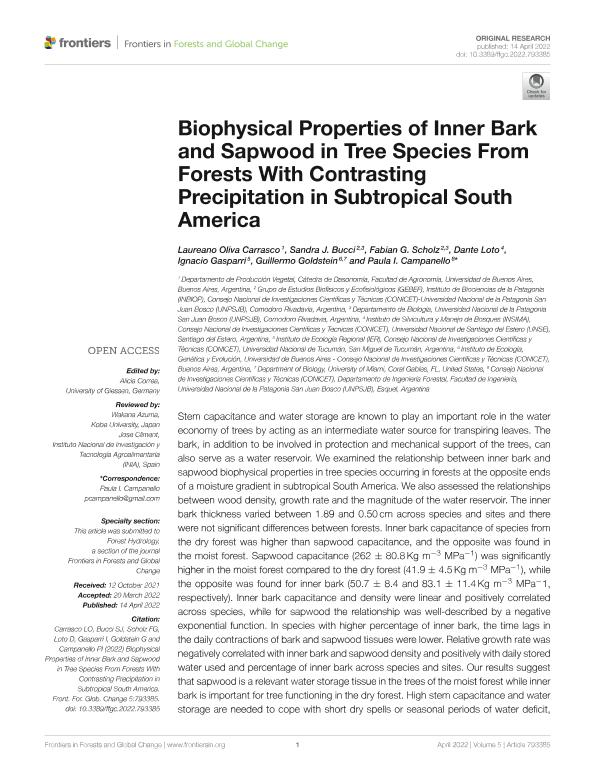Artículo
Biophysical Properties of Inner Bark and Sapwood in Tree Species From Forests With Contrasting Precipitation in Subtropical South America
Oliva Carrasco, Laureano ; Bucci, Sandra Janet
; Bucci, Sandra Janet ; Scholz, Fabian Gustavo
; Scholz, Fabian Gustavo ; Loto, Dante Ernesto
; Loto, Dante Ernesto ; Gasparri, Nestor Ignacio
; Gasparri, Nestor Ignacio ; Goldstein, Guillermo Hernan
; Goldstein, Guillermo Hernan ; Campanello, Paula Inés
; Campanello, Paula Inés
 ; Bucci, Sandra Janet
; Bucci, Sandra Janet ; Scholz, Fabian Gustavo
; Scholz, Fabian Gustavo ; Loto, Dante Ernesto
; Loto, Dante Ernesto ; Gasparri, Nestor Ignacio
; Gasparri, Nestor Ignacio ; Goldstein, Guillermo Hernan
; Goldstein, Guillermo Hernan ; Campanello, Paula Inés
; Campanello, Paula Inés
Fecha de publicación:
04/2022
Editorial:
Frontiers Media
Revista:
Frontiers in Forests and Global Change
ISSN:
2624-893X
Idioma:
Inglés
Tipo de recurso:
Artículo publicado
Clasificación temática:
Resumen
Stem capacitance and water storage are known to play an important role in the water economy of trees by acting as an intermediate water source for transpiring leaves. The bark, in addition to be involved in protection and mechanical support of the trees, can also serve as a water reservoir. We examined the relationship between inner bark and sapwood biophysical properties in tree species occurring in forests at the opposite ends of a moisture gradient in subtropical South America. We also assessed the relationships between wood density, growth rate and the magnitude of the water reservoir. The inner bark thickness varied between 1.89 and 0.50 cm across species and sites and there were not significant differences between forests. Inner bark capacitance of species from the dry forest was higher than sapwood capacitance, and the opposite was found in the moist forest. Sapwood capacitance (262 ± 80.8 Kg m−3 MPa−1) was significantly higher in the moist forest compared to the dry forest (41.9 ± 4.5 Kg m−3 MPa−1), while the opposite was found for inner bark (50.7 ± 8.4 and 83.1 ± 11.4 Kg m−3 MPa−1, respectively). Inner bark capacitance and density were linear and positively correlated across species, while for sapwood the relationship was well-described by a negative exponential function. In species with higher percentage of inner bark, the time lags in the daily contractions of bark and sapwood tissues were lower. Relative growth rate was negatively correlated with inner bark and sapwood density and positively with daily stored water used and percentage of inner bark across species and sites. Our results suggest that sapwood is a relevant water storage tissue in the trees of the moist forest while inner bark is important for tree functioning in the dry forest. High stem capacitance and water storage are needed to cope with short dry spells or seasonal periods of water deficit, and for maintaining growth rates. These stem properties will be more relevant under climatic scenarios with more frequent extreme drought events or seasonal reduction in precipitation in these forest ecosystems.
Archivos asociados
Licencia
Identificadores
Colecciones
Articulos(IEGEBA)
Articulos de INSTITUTO DE ECOLOGIA, GENETICA Y EVOLUCION DE BS. AS
Articulos de INSTITUTO DE ECOLOGIA, GENETICA Y EVOLUCION DE BS. AS
Articulos(IER)
Articulos de INSTITUTO DE ECOLOGIA REGIONAL
Articulos de INSTITUTO DE ECOLOGIA REGIONAL
Articulos(INBIOP)
Articulos de INSTITUTO DE BIOCIENCIAS DE LA PATAGONIA
Articulos de INSTITUTO DE BIOCIENCIAS DE LA PATAGONIA
Citación
Oliva Carrasco, Laureano; Bucci, Sandra Janet; Scholz, Fabian Gustavo; Loto, Dante Ernesto; Gasparri, Nestor Ignacio; et al.; Biophysical Properties of Inner Bark and Sapwood in Tree Species From Forests With Contrasting Precipitation in Subtropical South America; Frontiers Media; Frontiers in Forests and Global Change; 5; 4-2022; 1-13
Compartir
Altmétricas



